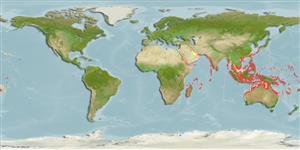分类 / Names
俗名 | 同种异名 | Catalog of Fishes(属, 种) | ITIS | CoL | WoRMS | Cloffa
Teleostei >
Eupercaria/misc (Various families in series Eupercaria) >
Caesionidae (Fusiliers) > Caesioninae
Etymology: Caesio: Latin, caesius, bluish-grey, 1835; it is the same name given to the silvery metal (Cs) (Ref. 45335).
More on author: Lacepède.
Environment: milieu / climate zone / depth range / distribution range
生态学
海洋 礁区鱼类; 非迁移的; 深度上下限 1 - 60 m (Ref. 30874). 热带; 34°N - 31°S, 30°E - 116°W (Ref. 94071)
Indo-West Pacific: Red Sea and East Africa to Samoa, north to southern Japan, south to New Caledonia. Absent in the Arabian (Persian) Gulf.
印度-西太平洋: 红海而且东非到美属萨摩亚, 北至日本南部, 南至新加勒多尼亚。 不存在于波斯湾。
大小 / 重量 / 年龄
Maturity: Lm ? range ? - ? cm
Max length : 45.4 cm FL 雄鱼/尚未辨别雌雄; (Ref. 125599); common length : 25.0 cm TL 雄鱼/尚未辨别雌雄; (Ref. 39189); 最大体重: 1.6 kg (Ref. 125599)
背棘 (总数): 10; 背的软条 (总数): 14-16; 臀棘 3; 臀鳍软条: 10 - 12. This species is distinguished by the following characters: postmaxillary process single; A III,12 (rarely 13); lateral line scales 57-65 (usually around 61); scale rows on spinous part of dorsal fin horizontal; supratemporal bands of scales often interrupted at dorsal midline by a scaleless zone, always a V-shaped scaleless zone anteriorly at midline intruding between the supratemporal band of scales; body colour with upper body bluish and the lower white to pale bluish; a single yellow or golden stripe directly above lateral line except on caudal peduncle where it is about 1 scale above lateral line, the yellow stripe 2 or 3 scales wide, bordered directly above and below by a white or light blue stripe which is about 1 scale wide, caudal-fin lobes with a black median streak (Ref. 68703).
在颊上有三到五个鳞片; 22-25个前背的鳞片; 背鳍与臀鳍覆有鳞片的。 鳞片的前期暂时条纹在中线前面地时常被一个 V 形无鳞片的区域中断。 上柄的鳞片列通常 11(10-12); 下柄的鳞片列通常 15.(14-15) 在 Baudelot 的结带的附着的基枕骨的每个腹侧表面方面的一种小的突起, 在分开从骨阜它的基枕骨的腹面上的一个突出的凹洼。 后颚的突起单个; 颚骨的后端钝的。 颜色: 身体上半部蓝色的, 身体下半部白色到灰蓝色的。 金的条纹从眼睛上方, 笔直地跑沿着对上尾部的梗身体而且继续上叶的尾鳍到顶端, 变成接近黑色的鳍之上。 第二个在下叶中的相似条纹.(参考文献 48636)
Adults are found in schools in deep lagoons and along seaward reefs in coastal areas (Ref. 9710), mixing with other species of fusiliers (Ref. 48636). Juveniles are used as tuna bait fish. They are oviparous, with small pelagic eggs (Ref. 402). Maximum depth reported taken from Ref. 128797.
栖息于沿岸区域, 主要地珊瑚礁的周围。 成群出现在深的舄湖中而且沿着临海礁石 (参考文献 9710), 以其他种的笛鲷科鱼类混合.(参考文献 48636) 稚鱼用作了鲔鱼诱饵鱼。 卵生的, 与小型大洋性鱼类卵.(参考文献 402)
Life cycle and mating behavior
成熟度 | 繁殖 | 产卵场 | 卵 | 孕卵数 | 仔鱼
Mating behavior is marked by six distinguishable patterns, namely: 1) nuzzling; 2) several males joining in courtship; 3) spiraling towards the surface; 4) pair spawning; 5) sperm release by sneakers; and 6) post spawning.
Nuzzling is done about 1-1.5 hours before spawning. For most of the day the fish swam slowly in school. At nearly spawning time, one or two males approach a selected female and begin pecking and pushing her swollen abdomen with their snouts. Interruption happens at this stage resulting in spawners returning to the school. With less than an hour until spawning, 2-6 males may attempt to get their abdomen as close to the female's abdomen as possible. For the pair that completes this position, a spiraling ascent to the surface occurs followed by a release of both eggs and sperm while other males come in pursuit. These sneakers release sperm at the same spot where the initial pair had released their gametes. Some spawnings may occur without sneakers getting involved in the process (Ref. 37498).印度-西太平洋: 红海而且东非到美属萨摩亚, 北至日本南部, 南至新加勒多尼亚。 不存在于波斯湾。
Carpenter, K.E., 1987. Revision of the Indo-Pacific fish family Caesionidae (Lutjanoidea), with descriptions of five new species. Indo-Pac. Fish. (15):56 p. (Ref. 1723)
人类利用
渔业: 商业性; 诱饵: occasionally
更多信息
参考文献养殖养殖信息品种遗传学Electrophoreses遗传率疾病加工NutrientsMass conversion
工具
特别资料
下载 XML
网络资源
Estimates based on models
Preferred temperature (Ref.
123201): 24.7 - 29, mean 28 °C (based on 814 cells).
Phylogenetic diversity index (Ref.
82804): PD
50 = 0.5020 [Uniqueness, from 0.5 = low to 2.0 = high].
Bayesian length-weight: a=0.01349 (0.00821 - 0.02216), b=3.06 (2.92 - 3.20), in cm total length, based on LWR estimates for this species & (Sub)family-body (Ref.
93245).
营养阶层 (Ref.
69278): 3.4 ±0.45 se; based on food items.
回复力 (Ref.
120179): 中等的, 族群倍增时间最少 1.4 - 4.4年 (Preliminary K or Fecundity.).
Fishing Vulnerability (Ref.
59153): Moderate vulnerability (40 of 100).
Nutrients (Ref.
124155): Calcium = 58.9 [38.9, 86.2] mg/100g; Iron = 0.742 [0.489, 1.080] mg/100g; Protein = 19 [18, 20] %; Omega3 = 0.141 [0.098, 0.203] g/100g; Selenium = 32.6 [20.7, 55.2] μg/100g; VitaminA = 102 [42, 251] μg/100g; Zinc = 1.14 [0.83, 1.52] mg/100g (wet weight);
